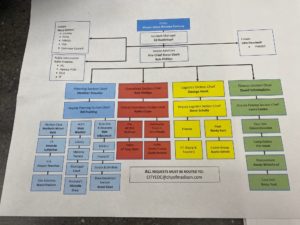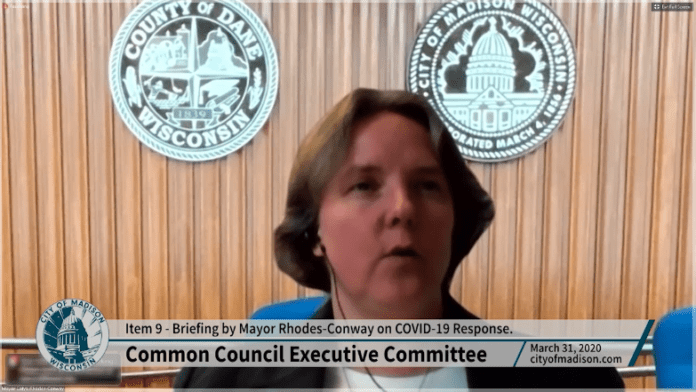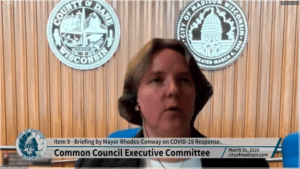Mayor walks through the priorities, what they are working on, how they are working, how they reassigned staff and much more.
This is from the Common Council Executive Committee meeting on March 31st, 2020. Here’s the agenda for the meeting. The rest of the meeting is here.
You can follow along here, about an hour into the meeting
GETTING STARTED
COVID-19 RESPONSE
- Briefing by Mayor Rhodes-Conway on COVID-19 Response (<- link decoy. i.e. nothing in the link)
Mayor Satya Rhodes Conway says she has a long update, she will try to do it quickly. There are a few deputy mayors and staff on the line that can answer questions as well. I’m going to just hit the highlights, not type verbatim.
Opening remarks
- We are lucky to have relatively low numbers of COVID-19 and only a couple of deaths, but even one is too many.
- We are still in the early phases of this and we expect it to get worse before it gets better.
- We know this is having a disproportionate negative impact on our most vulnerable populations
- It presents a tremendous challenge to our health care workers and health care system, our first responders and other essential city staff.
- It presents a tremendous challenge to our economy and every household.
- Main focus remains flattening the curve to prevent overwhelming the health care system
- We still have to protect and sustain our essential services and protect our employees
How do we do this?
- They are trying to maintain an equity lens on the work they are doing
- They restructured substantial portions of city government using the incident command structure and creating the Emergency Operations Center (EOC) – so they can respond quickly and meet emerging needs as they emerge and work more effectively across silos. She has been impressed with cutting across those barrier
EOC Structure
- She says they all got the flowcharts at the last CCEC.

- Structure is based on National Incident Management System and the Incident Command System, it has four sections but a JIC (Joint Information Center) and a liaison capacity which is their connection to other institutions.
- Information coming in to the EOC is triaged through three people, the incident manager (Ed Ruckreigel) and the senior advisors (Chief Davis, Chief Wahl and Rob Phillips). They see all the emails coming in and decide what to do with them. There has been about 600 requests in a week, so they have asked high volume groups (Mayor’s Office and Council) to aggregate through individuals. Mayor’s office is through her or Chief of Staff, in your case it’s your Chief of Staff, so they can respond to patterns and issues, rather than every individual request.
- Every email is read, not all directly responded to but there is a daily log.
- Requests get routed to someone by the three people triaging the items.
- Sometimes they go back to the person who sent them saying its something you can deal with and we encourage you to do so.
- Sometimes they get routed to one of sections of the EOC to work on.
- Informational things go to JIC
- Forward looking planning things goes to planning section
- An operation need goes to Operations section
- Incident command has daily meetings, its a small group of people so the meetings stay productive. They meet every morning for information sharing and problem solving. Mostly reporting back from the sections on what happened the last 24 hours.
- They have robust communications with other EOCs. They have liaison from Public Health Madison/Dane County who report. Our incident manager has daily contact with the state EOC, Dane County EOC (three times a week) and UW (2 times a week). All EOCs are connected through liaisons or regular briefings.
- Staff are working on finalizing the pandemic plan, that will be available in a week or two and will be shared with council.
- Structure of EOC is 106 staff. Some are part-time, some are full time.
- 4 sections (planning, operations, finance and logistics) have working groups underneath them
- Planning section is working on
- determining which services are essential
- a framework for reallocating staff between services
- working on election
- workgroup studying worst case scenarios and working on planning for them
- workgroup on re-purposing manufacturing locally to meet needs
- workgroup on economic recovery
- workgroup on teleworking for managers and employees
- workgroup on emergency order mayor issued
- Operations section is working on
- Public Health, Fire, Police, Public Works, Community Services, Homeless facilities and election
- Logistics section is working on
- Homeless facilities, purchasing, inventory, personnel, with emphasis on PPE and cleaning supplies
- Finance section is working on
- Cost tracking, purchasing, time tracking, monitoring federal and state legislation, risk management and safety services
- Planning section is working on
- Liaison function is led by her chief of staff and deputy mayor Cam McLay and they are working with major institutions in the community, they are expanding their reach to community groups and they have a research section that is looking at what other communities are doing in response to the virus.
- The Joint Information Center (JIC) is working across media on sharing good information and getting the message out including, website, email, social media, standing up a newsletter, exploring text alerts and making sure we are getting things translated and/or interpreted as necessary.
Staffing Challenges
- As of March 28th, 480 staff, 16% of positions, have reported 11,580 hours against the COVID-19 project. Staff are all asked to track their time when they are working on something related to the virus.
- They are working to track leave usage to get a sense of how many people have been impacted. The new emergency leave (2 weeks for all employees) as of March 28, 213 employees have used 3,817 hours of the emergency leave. The average use is 18 hours per employee.
- They have spent over $108,435 on the COVIID-19 response. That is not counting staff time, that is just expenditures
- They have major upcoming expenditures, a hotel block for first reponsders which would be $165,000
- $50,000 in purchases in progress
- 106 staff are dedicated to the EOC and they are working on staff re-deployment numbers. 10-30 staff have been retasked to work in the clerk’s office and 8 agencies have been able to move staff there – library, parking utility, parking enforcement, parks, Monona Terrace, planning, building inspection and fire.
- They have 75 – 150 employees from other city agencies that have been re-deployed to assist with the absentee ballot backlog.
- Librarians and other staff have been retasked with doing policy and research.
- That is close to 200 employees doing something different than their regular job and it may be more with people in departments being moved to urgent matters.
- They have 1300 staff teleworking part-time if not full-time.
- They established a framework for essential services, and determined department by department what could be delayed or stopped for the moment and the varying levels of risk involved with these. Services are broken into
- Agencies that do not have field services or are able to completely telework – 8 agencies are 100% teleworking.
- For field services they have
- Essential field services that must continue – there are 69 essential field services identified. Priorities are
- Ensuring safety of employees
- Reallocating staff from other categories to maintain the services
- Non-essential field services – can be accomplished without multiple staff coming in contact with each other – solo field services. There are 63 of these, the departments were asked to determine if the work is still relevant and if it can safely continue, it should. If it is not currently relevant, then they are asking the staff to be re-allocated within the agency to the essential services category, if that is not possible then internally they are asking them to reallocate to other essential services. Only as a last resort would people be put on paid administrative leave.
- Non-essential services that involve teams – 31 services. Because we are practicing social distancing the priority is to reassign staff to be on projects that can be accomplished solo or to more essential projects. If that’s not possible reassign throughout the city or if that’s not possible then paid administrative leave.
- Essential field services that must continue – there are 69 essential field services identified. Priorities are
- In general they are trying to keep people working on things that are most important in the city.
- HR has issued guidance and FAQs and there will be an APM soon on the use of leave, how managers should think about accommodating workers, how they can think about risk and risk assessment so the workers that are most vulnerable themselves or because of family members can be accommodated and taken care of. Most of the guidance is or will be available on employeenet, which she thinks the alders can access.
Hurculean Efforts by staff
- Clerks office – curbside voting, 72,000 absentee ballots, 3,000 pending requests, losing polling places and poll workers, still managing to plan for an election which we may or may not have on the 7th.
- IT Department – work to make virtual meetings, also telework for the entire city and increasing demand from the clerk’s office and front line agencies, the EOC has needs, the process to reallocate staff across departments is a virtual process that relies on IT, plus normal maintenance of IT systems
- Treasurer’s Office – has stayed open for walk up the whole time, they are taking on walk up from other agencies, like municipal court, the police department, parks, building inspection, building permits, engineering permits are all going through the treasurer’s office now.
- Metro is maintaining modified service at reduced capacity and cleaning all the buses between every shift and doing as much as they can to keep passengers safe. They are maintaining service to the hospitals so health care workers can get to work.
Issues that they are focusing on
- First and foremost is flattening the curve, prevent spread of virus, preserve hospital capacity. She says they should look at the dashboard regularly.
- Essential services – protecting workers, maintaining staff levels, payroll and vendor payments have to continue.
- They are talking about closing MMB and CCB post election to walk up. You will still be able to get in, along with employees.
- Election – they did file an amicus brief with the federal court yesterday asking to postpone the election by 3 weeks. Allowing all officials to stay in office until the results of the postponed election and consider an all absentee election.
- Census – weaving that message into what they are putting out
- Making sure this body and the council can meet virutally and additional committees as quickly as we can. She is hopeful they can do that relatively quickly.
- Many services have gone remote – going relatively well
- Virtual library card
- Development review process mostly entirely remote
- Many of the ways the residents contact the city is all online or over the phone
- Some services suspended because it is not safe to provide them or because there is insufficient staff
- Yard waste drop off
- Public Works contracts on hold til safety measures in place – will start again next week, engineering worked hard to get instructions to contractors to make sure workers were protected
- Public health services are on pause that require direct contact.
- Focused on providing services for vulnerable populations
- Everyone have access to nuitritious food
- Work to protect homeless community – 274 at risk folks in hotels, that were formerly homeless, opened up Warner Park Center as homeless shelter for single men overnight to create greater physical separation. Working with Dane County and non-profits on this and continuing to plan, we’re not done there.
- Senior Center has been doing amazing work to connect with Seniors
- Trying hard to make sure reaching out to non-english speaking populations and folks who are differently abled to meet their needs.
- Coordinating with other levels of government
- In regular contact with governor’s office, the county, the school districts, the hospitals, UW, United Way and a number of different community organizations as well as tracking national organizations and what is going on at the federal level
- Beginning to think about mitigating the economic impact on the community, coordinating with the Chamber but also the Black Chamber and Latino Chamber and other business organizations.
- They haven’t started on any sort of recovery planning yet.
Ask from EOC to the Council
- Be thinking about recovery planning and recovery policy. She hopes CCEC or some other format can take the questions on about the long term impacts in our community and what we should be doing now to plan for them. Once we are able to start approaching business as usual again
Wrap Up
- This has completely re-oriented all of her priorities and most of the city’s priorities.
- There are a lot of things we wanted to do that will have to be on hold for a good long time now.
- But “we shouldn’t waste a good crisis. And we should be thinking about how we can come back from this thing stronger and in a more equitable way, and in building up the structures that we want to see in our city in the long term. I think there is an opportunity to do that now, and she hopes that you agree and we can work together on that.”
The rest of the CCEC meeting, including the alder discussion follow up, is here.









